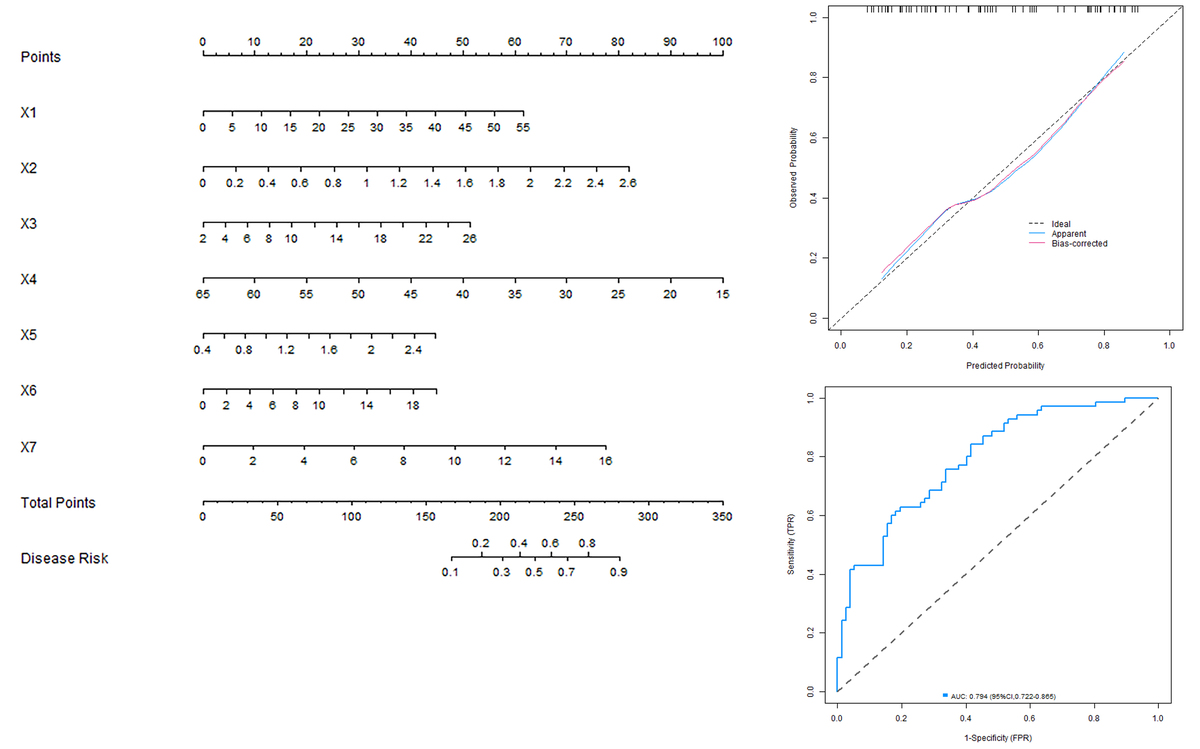Current issue
Archive
Manuscripts accepted
About the Journal
Editorial office
Editorial board
Section Editors
Abstracting and indexing
Subscription
Contact
Ethical standards and procedures
Most read articles
Instructions for authors
Article Processing Charge (APC)
Regulations of paying article processing charge (APC)
NEUROLOGY / RESEARCH PAPER
Development and Validation of a Nomogram Prediction Model for Delayed Cerebral Edema After Intracerebral Hemorrhage Based on Serum Inflammatory Markers and Hemodynamics
1
The Fifth Affiliated Hospital of Zhengzhou University
Submission date: 2024-12-02
Final revision date: 2025-02-13
Acceptance date: 2025-06-10
Online publication date: 2025-06-22
Corresponding author
KEYWORDS
TOPICS
ABSTRACT
Introduction:
To explore the risk prediction model of delayed cerebral edema after hypertensive cerebral hemorrhage based on serum inflammatory factors and hemodynamics and its clinical application value.
Material and methods:
Multivariate Logistic regression was used to analyze the risk factors of postoperative bleeding and build a nomogram prediction model, and ROC curve and calibration curve were drawn to evaluate the prediction efficiency of nomogram model, which was verified in the verification set.
Results:
The results of univariate analysis showed that there were significant differences in L-6, TNF-α, IL-1β, MIP-1α, CBF, CVR, HMGB1 and CRP between patients with edema and those without edema in training (P<0.05). Logistic regression analysis showed that L-6, TNF-α, IL-1β, CBF, CVR, HMGB1 and CRP were independent risk factors for bleeding (P<0.05). The nomogram model has good calibration and fitting degree between prediction and reality in training set and verification set (C-index index is 0.792 and 0.799). The results of HosmerLemeshow test are χ2=16.582, P =0.035 and χ2=7.472, P = 0.487. The ROC curve is shown in the training set and the validation set. The AUC of the nomogram model in predicting delayed cerebral edema is 0. 794 and 0. 796.
Conclusions:
The nomogram prediction model of delayed cerebral edema after hypertensive cerebral hemorrhage based on serum inflammatory factors (IL-6, TNF-α, IL-1β), hemodynamic parameters (CBF, CVR) and other related factors (HMGB1, CRP) was successfully established. The model can effectively predict the risk of delayed cerebral edema in patients with hypertensive cerebral hemorrhage.
To explore the risk prediction model of delayed cerebral edema after hypertensive cerebral hemorrhage based on serum inflammatory factors and hemodynamics and its clinical application value.
Material and methods:
Multivariate Logistic regression was used to analyze the risk factors of postoperative bleeding and build a nomogram prediction model, and ROC curve and calibration curve were drawn to evaluate the prediction efficiency of nomogram model, which was verified in the verification set.
Results:
The results of univariate analysis showed that there were significant differences in L-6, TNF-α, IL-1β, MIP-1α, CBF, CVR, HMGB1 and CRP between patients with edema and those without edema in training (P<0.05). Logistic regression analysis showed that L-6, TNF-α, IL-1β, CBF, CVR, HMGB1 and CRP were independent risk factors for bleeding (P<0.05). The nomogram model has good calibration and fitting degree between prediction and reality in training set and verification set (C-index index is 0.792 and 0.799). The results of HosmerLemeshow test are χ2=16.582, P =0.035 and χ2=7.472, P = 0.487. The ROC curve is shown in the training set and the validation set. The AUC of the nomogram model in predicting delayed cerebral edema is 0. 794 and 0. 796.
Conclusions:
The nomogram prediction model of delayed cerebral edema after hypertensive cerebral hemorrhage based on serum inflammatory factors (IL-6, TNF-α, IL-1β), hemodynamic parameters (CBF, CVR) and other related factors (HMGB1, CRP) was successfully established. The model can effectively predict the risk of delayed cerebral edema in patients with hypertensive cerebral hemorrhage.
Share
RELATED ARTICLE
We process personal data collected when visiting the website. The function of obtaining information about users and their behavior is carried out by voluntarily entered information in forms and saving cookies in end devices. Data, including cookies, are used to provide services, improve the user experience and to analyze the traffic in accordance with the Privacy policy. Data are also collected and processed by Google Analytics tool (more).
You can change cookies settings in your browser. Restricted use of cookies in the browser configuration may affect some functionalities of the website.
You can change cookies settings in your browser. Restricted use of cookies in the browser configuration may affect some functionalities of the website.



